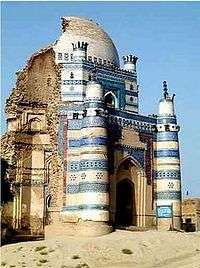Tomb of Bibi Jawindi

The Tomb of Bibi Jawindi is one of the five monuments in Uch Sharif, Punjab, Pakistan, that are on the tentative list of the UNESCO World Heritage Sites.[1] Dating to the 15th century, the shrine was built in 1493 by an Iranian prince, Dilshad,[2] for Bibi Jawindi, who was the great-granddaughter of Jahaniyan Jahangasht, a famous Sufi saint.[1]
Location
The site is located in the south-west corner of Uch, a historical city founded by Alexander the Great,[3] in the Bahawalpr state and Punjab province of Pakistan.[1] Uch, locally known as Uch Sharif, is known as the home of the "shrine culture" because of its cultural significance and the presence of several monuments and shrines.[4]
Architecture
Considered one of the most ornate monuments in Uch, the tomb of Bibi Jawindi is an important site for visitors.[5] The exterior of the building is octagonal in shape and has three tiers with the top one supporting a dome, while the interior is circular due to thick angled walls rising up two stories. Both the interior and exterior of the building are richly decorated with Islamic scriptures, carved timber, and bright blue and white mosaic tiles known as faience.[1][5][6] The base tier is supported by eight tapering towers in each corner.[1] The compound enclosing the shrine is preserved in its original desert-like conditions and is mostly covered with cemented graves. The surrounding area is covered with green vegetation due to a network of river tributaries and canals crossing the area.[4]
World Heritage Site
The site was submitted by the Department of Archaeology and Museums Pakistan in January 2004 to be inducted in the World Heritage Sites along with four other monuments in the region. These monuments are the Shrine of Baha'al-Halim, Tomb of Ustead (the architect), Shrine of Jalaluddin Bukhari, and the Mosque of Jalaluddin Bukhari. The site was submitted under the criteria ii, iv, and vi in the cultural category. As of 2012, it is still on the tentative list.[1]
Conservation

Over the centuries, the tomb has badly disintegrated as a result of environmental conditions, and during torrential floods in 1817 half of the structure was washed away.[2] Only half of the structure remains today.[4] In 1999, the Conservation and Rehabilitation Center of Pakistan invited international bodies and city officials to work on the conservation of the site. However, because of humidity, salt infiltration, and erosion the complex monuments are still crumbling. Inappropriate methods of repair have further damaged the complex. The World Monuments Fund placed the structure on their Watch in 1998, 2000, and 2002 to gather international attention and obtained grants to conserve the tombs.[3]
Gallery
- A view of the graves in the tomb enclosure with surrounding vegetation
 Close up view of the mosaic tiles decorating the mausoleum
Close up view of the mosaic tiles decorating the mausoleum Side view of the tomb showing only half the structure is still standing
Side view of the tomb showing only half the structure is still standing Tomb of Bibi Jawindi, 2013
Tomb of Bibi Jawindi, 2013 Front wall of the tomb
Front wall of the tomb
See also
| Wikimedia Commons has media related to Bibi Jawindi's Tomb. |
References
- 1 2 3 4 5 6 "Tomb of Bibi Jawindi, Baha'al-Halim and Ustead and the Tomb and Mosque of Jalaluddin Bukhari". World Heritage Sites. UNESCO. Retrieved 18 September 2012.
- 1 2 "Bibi Jawindi Mausoleum ( Pakistan )". OIC Research Center for Islamic History, Art, and Culture. Retrieved 20 September 2012.
- 1 2 "Uch Monument Complex". World Monuments Fund. Retrieved 18 September 2012.
- 1 2 3 "Uch Sharif: where the shrine culture began". Dawn news. Retrieved 18 September 2012.
- 1 2 "Bibi Jawindi Tomb". ArchNet. Retrieved 18 September 2012.
- ↑ "Faience". About.com. Retrieved 18 September 2012.
